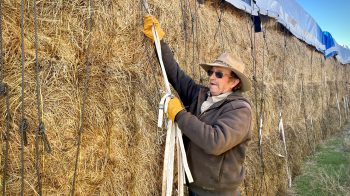The end of phosphorus
KAI RYSSDAL: You’ve heard, perhaps, of the theory of peak oil — the idea that there’s only so much crude out there to be had and when we start to run out, that’s it.
There’s another critical resource out there whose coming peak has gotten much less attention. But unlike oil, it has no alternative. We truly can’t live without phosphorus. The vast majority of the world’s supply is locked up in just one country. So how do we fight the coming phosphorus shortage?
The answer, says Marketplace’s Jeff Horwich, lies not in our stars, but — quite literally — in ourselves.
JEFF HORWICH: Unless you’re a farmer or a serious gardener, you probably just remember phosphorus from high school — as an element on the periodic table. So first, a quick science lesson.
JIM ELSER: The joke goes that phosphate “holds your genes up.”
Ecologist Jim Elser at Arizona State University says phosphorus binds our DNA together. No phosphorus, no new DNA — nothing can grow.
ELSER: There’s no substitute for phosphorus in agriculture or in biology — we can’t just swap something else in there, that’s not going to work.
That’s why it’s a critical ingredient in fertilizer. If you buy “10-10-10,” say for your garden, that middle number — that’s phosphorus. Here’s the problem: The world uses so much fertilizer, and so much phosphorus — and there’s only so much in the ground. Which brings us to a geography lesson.
ELSER: Morocco is the kingpin of phosphate right now — 85 percent of the global phosphate reserves are now identified in Morocco.
And the government — the kingdom — controls all of it. So what usually happens when you have insatiable demand and closely held supply? Well, phosphate prices are up 150 percent since 2007; 60 percent in just the last year. Fertilizer is already too expensive for many farmers in Africa. American farmers and consumers feel that same pinch.
But using less phosphorus — that’s a limited option, says ecologist Larry Baker at the University of Minnesota. The growing world’s gotta eat.
LARRY BAKER: We’re going to have a population of 10 billion people and extremely limited phosphorus reserves if we continue to use them the way we do now. And perhaps a lot of starvation and hardship could follow.
So other than digging in Morocco, where do we get more phosphorus? Here’s a hint: the symbol for phosphorus on the periodic table… is “P.”
LARRY JACOBSON: And there it is — the valuable byproduct.
HORIWCH: All over the place.
JACOBSON: All over the place.
Larry Jacobson’s a manure engineer — yes, that’s a thing — also at the University of Minnesota. And yes, there are cows and, on this day, lots of sheep right on campus doing their thing: Phosphorus grows plant; animal eats plant; animal shoots much of the phosphorus right back out again — if you can catch it before it washes away. Jacobson says U.S. farmers, facing fertilizer prices, are getting much more efficient at this kind of thing.
JACOBSON: Animal manures have been used for crop nutrients for centuries, for eons. This is old stuff. We just had to kind of relearn it and reassess how valuable it is.
Of course, cows and sheep aren’t the only chewing, grunting phosphorus factories walking around out there. That’s right — I’m looking at you.
MIKE MERENESS: Coming into the plant is something on the order of five tons a day of phosphorus.
Mike Mereness directs one of the largest sewage plants in the country, The Metropolitan Wastewater Treatment Facility. When you flush in the Twin Cities metro area, it probably goes here. It is state of the art when it comes taking the phosphorus out of the water — environmental regulations demand it. But then, like many U.S. plants, it burns it — for power. The incineration leaves behind a phosphorus-rich ash that gets hauled to the landfill.
MERENESS: It’s there to be recovered. I could envision in the future where maybe the economics change on the value of phosphorus, where there’s more of a focus on our ash and phosphorus in our ash.
Many older, less state-of-the-art sewage plants do truck their treated solid waste to area farm fields. That, paradoxically, is the way of the future, says the University of Minnesota’s Larry Baker.
BAKER: Recycling in the face of resource scarcity is not a new idea. It’s just we now will probably have to do this with phosphorus.
In a new paper, Baker calculates how much phosphorus could be conserved or reclaimed in his home region, the Twin Cities.
BAKER: The phosphorus you recycle could feed two-thirds of the people in the area using current agricultural techniques. And you could get more efficient — I wasn’t even trying very hard.
Baker did assume some things that might feel far fetched: Returning to a 1978 diet, for example, and dialing back the size of our dogs — pet food is a major phosphorus user. But that seems to be the thing with phosphorus: to deal with the future, we might have to go back in time.
In St. Paul, Minn., I’m Jeff Horwich for Marketplace.
CORRECTION: A previous version of this article incorrectly identified Jim Elser as an Ecologist at University of Arizona. He is with Arizona State University.
There’s a lot happening in the world. Through it all, Marketplace is here for you.
You rely on Marketplace to break down the world’s events and tell you how it affects you in a fact-based, approachable way. We rely on your financial support to keep making that possible.
Your donation today powers the independent journalism that you rely on. For just $5/month, you can help sustain Marketplace so we can keep reporting on the things that matter to you.


















